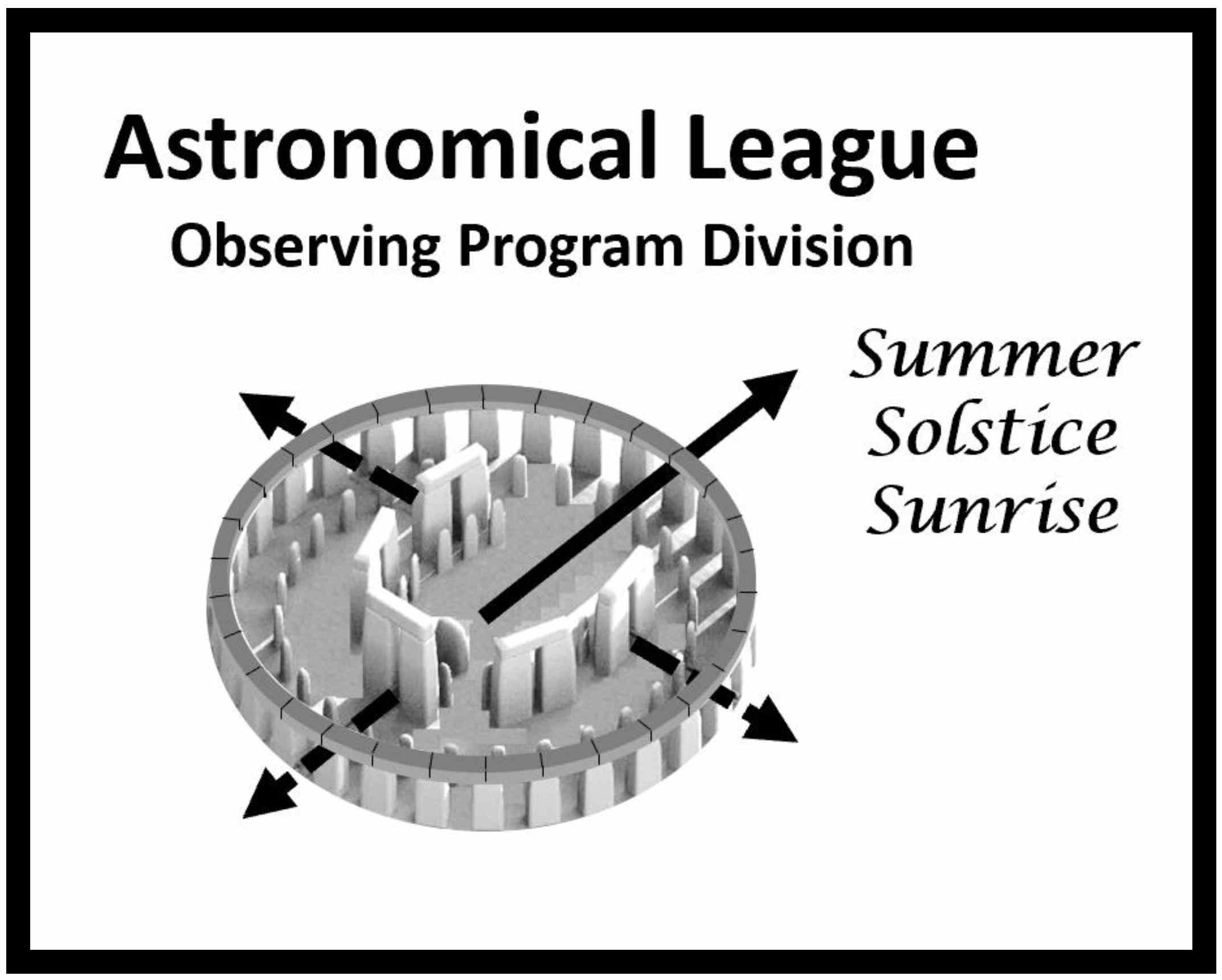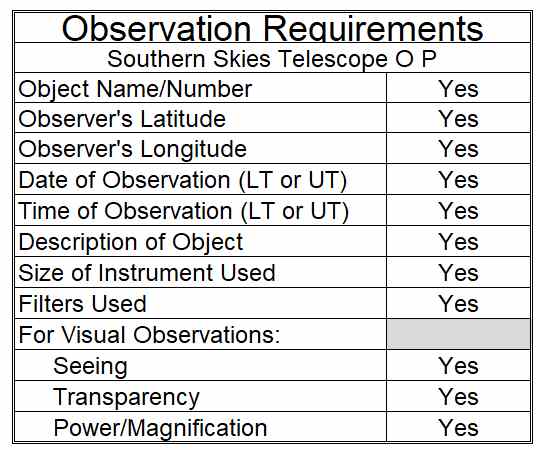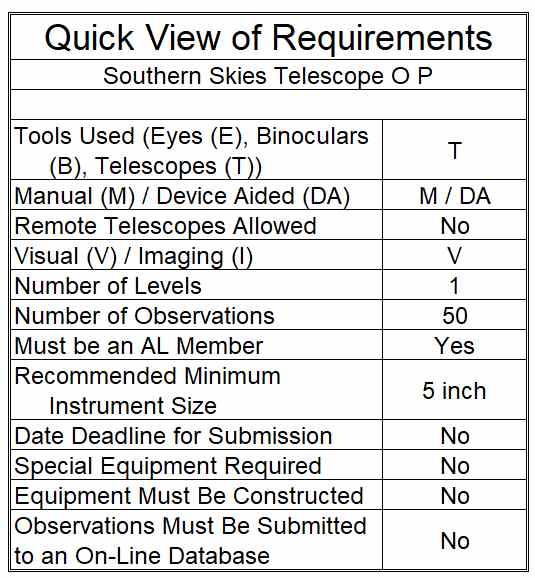Southern Sky Telescopic Observing Program Coordinator:Kathy Machin |
 |
Background Information
Observing the Objects:
All the objects on this list will be visible in a small telescope in good dark skies. Although many are visible in large binoculars, a telescope is very highly recommended for this project. Those wishing to observe with binoculars should pursue the Astronomical League Southern Sky Binocular Observing Program list rather than this list. Particularly with the planetary nebula, higher magnifications are needed than can be provided by binoculars. The galaxies on the list will also benefit greatly from the added aperture of a telescope. All of these objects can be seen in a 5-inch (125mm) or larger telescope. Certainly, more than half can be seen in an 80mm scope under dark skies.
Many of the objects in this observing program are also in the Astronomical League’s Southern Skies Binocular Observing Program, Caldwell Observing Program, and Messier Observing Program. There are even a few bright Arp objects. Any observer intending to use the same set of observations for multiple programs must keep in mind the varying requirements. The Messier and Caldwell Observing Programs, for example, do not allow computer-controlled (go-to) telescopes.
You will need a star chart to find the objects. If you have a computer charting program, you might wish to print out charts to help you find the objects. Plan ahead to maximize your observing time, you will need to know what will be visible at your site. At some times of the year, such as late September, it may be difficult to view the required number of objects without careful planning. Some objects may not be listed in your atlas or computer program at all, or an alternate name may be used. In that case, look at your charts for the other objects in the group and check at the given coordinates.
Requirements and Rules:
This certification is available to members of the Astronomical League, either through their local astronomical society or as members at large. If you are not a member and would like to become one, check with your local astronomical society, search for a local society on the Astronomical League Website (click here), or join as a Member-at-Large (click here).
To Earn a Southern Sky Showpiece Award:
If you belong to a club that is affiliated with the Astronomical League, one of your club officers may verify your observations and notify the Astronomical League. If you do not belong to a club, but joined the Astronomical League as a Member at Large, you can send your observations directly to the Observing Program Coordinator at the address given on this web page. Send only copies of your observations in case they get lost in the mail, and remember to mention that you are a League Member at Large. In return, you will receive a certificate, and a pin celebrating your accomplishment. |
 |
Your Observing Log:
- Seeing – is an indicator of how steady the atmosphere is. There are many excellent ways to evaluate seeing. For example – a scale of 1-5 with 1 being a perfectly steady image and 5 being violent turbulence. A simple standardized scale often used for Astronomical League Observing Programs is:
- E (excellent) – The brighter stars are not twinkling at all.
- VG (very good) – The stars are twinkling slightly, but the brighter planets are not twinkling.
- G (good) – The brighter planets are twinkling slightly.
- F (fair) – The brighter planets are obviously twinkling.
- P (poor) – The atmosphere is turbulent. all objects are twinkling to the points where observation is not practical.
- Transparency – this is a measure of how faint you can see. This can be affected by humidity, dust, natural sky glow, moonlight, pollution, and observing altitude. Estimating the magnitude of the faintest star you can see is a simple measure of transparency. Whatever scale you use, try to be consistent.
About the Objects:
The choice of objects for any Observing Program is highly subjective. You will no doubt find some great objects that were overlooked, and some duds that were included. Beyond a few obvious choices (such as 47 Tucanae and the Eta Carina nebula) various observers will have different favorites. For an observing program such as this, we also wanted to have objects available at any time of year for a dedicated observer to complete the program in one trip South. And, we wanted the list of objects to include an assortment of types of objects. The list is heavy on globular clusters, as these wondrous balls of stars are concentrated around the center of our galaxy– – and the center of our galaxy is south. The list also includes several “objects” that are really groups or pairs of objects that are visible in one low-power eyepiece field of view. For purposes of the Observing Program certification, you only need to see one of the objects in the group. Most of the time, you should be able to see them all.
Far South: -65 to -90 degrees; The Magellanic Clouds and South
This group of objects includes 47 Tucanae, the second brightest globular in the sky, the Small Magellanic Cloud (SMC), and the Large Magellanic Cloud (LMC). This is the territory for observing objects in other galaxies!
- The SMC is relatively poor in easily visible star clusters and nebula. By contrast, the LMC is a wonderfully rich area to explore. It would be easy to spend weeks viewing the clusters and nebula in the LMC. By far the most notable nebulosity in the LMC is the Tarantula Nebula. The list includes it, and some interesting fields in the LMC. You will find that it is difficult to find a field with just one or two patches of stars or nebula. Enjoy!
Mid-South: -48 to -65 degrees; The Southern Milky Way Band
This area is between Omega Centauri and the Magellanic Clouds. It includes a swath of the Southern Milky Way including Eta Carina, the Coal Sack and the Jewel Box cluster. This is an area very rich in open clusters of all sizes. If you are lucky enough to observe in truly dark transparent skies, look for the dark nebula tracking through the Milky Way and bordering many of the open clusters. Three double stars and two dark nebulae are included in the group for a change of pace.
- Proxima Centauri, the nearest star to our sun, is a very faint 11th magnitude companion of Alpha Centauri. It is about 2 degrees from Alpha, and impossible to identify with certainty without a detailed finder chart. For that reason, it is not included on this list.
- Keyhole Nebula – the Keyhole Nebula is a small, curved, dark dust lane crossing the brightest portion of the Eta Carina nebula. It is located west of the star Eta Carina. The keyhole shape has become less apparent over the years because of changes in Eta Carina and the associated nebulosity. A filter may make the dark nebula easier to spot by increasing the contrast between the bright and dark nebula.
The Other Group: -47 to -11 degrees:
This group includes Omega Centauri, Centaurus A, the Helix and a number of Messier objects.
Why include objects that can be seen from mid-north latitudes at all? Atmosphere! If you observe an object at just 30 degrees above the horizon, you are looking through twice the distorting layer of atmosphere than if the object is directly overhead. That additional layer of atmosphere causes a significant loss of detail. These familiar objects are on the list in the hope that you will take the time to look at them when they are at their best – high above the horizon. Observe them when they are 45 degrees or more above the horizon and you will be rewarded with a new appreciation of your old favorites.
John Bambury’s List of Southern Skies Objects:There are a number of observing target lists for those who live in the southern hemisphere. One we highly recommend is John Bambury’s List of Southern Skies Objects (PDF format, Excel format) (updated 2024-01-01). The 600 objects on this list provide a more extensive compilation of great targets if you live south of the equator, or can spend more than a couple of nights observing from the southern hemisphere. This list is designed for southern hemisphere observers, yet it includes some objects, such as the Andromeda Galaxy, that are further north than objects normally considered “southern”. Take a look, choose your targets, and Enjoy! The Astronomical League is issuing a joint certificate with OZSKY for observations of all 600 objects. You do NOT need to be a member of the Astronomical League. The rules and requirements are basically the same as for the Southern Sky Telescope Observing Program, BUT:
Additional information and various list formats are available on the OZSKY website: |
 |
Submitting for Certification
To receive either certification, please send your completed logs to the Southern Sky Telescopic Observing Program Coordinator or have them reviewed and approved by an officer of your astronomy club who can then email the Coordinator. Be sure to specify whether you are submitting for the Southern Sky Telescope Observing Program or the Bambury 600 Observing Certificate. Include your name, mailing address, email address, phone number, society affiliation, and to whom the certification should be sent.
Southern Sky Telescopic Observing Program Coordinator:Kathy Machin |
 |
Upon verification of your submission and of your active membership in the Astronomical League, your recognition (certificate, pin, etc.) will be sent to you or to the awards coordinator for your society, as you specified. Your name will also appear in an upcoming issue of the Reflector magazine and in the Astronomical League’s online database. Congratulations. Good luck with your next observing challenge.
Notes:
- Acknowledgments: This observing program is dedicated to the memory of the late Ken Wilcox, who had the courage to start the Southern Skies Star Party in Bolivia. Great thanks are also due to Jen Dudley Winter and the late Vic Winter, who ably continued and expanded on Ken’s vision.




